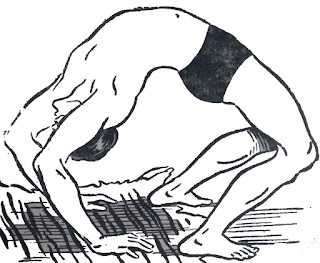Chakrasana or wheel pose is a back bend asana/pose that needs some extra strength to do. It is also called as Urdhva Dhanurasana means Upward Bow pose. In this post, we will learn how to do Chakrasana or wheel pose. To know about Dhanurasana, please read our post How to do Dhanurasana.
2. Your hands must be placed behind your shoulders, ensuring your fingers are opened up and pointed towards your shoulders.
3. Once you feel comfortable in this stance, balance your weight on your limbs. Then, press your feet and palms, and lift your entire body off the floor. Let your head hang gently. Your neck should be long.
4. Make sure you breathe comfortably. Take slow, deep breaths.
5. Hold the pose for a minute, or as long as you are comfortable. Then, release by bending your arms and legs, and gently lowering your back on the ground. Lie down in Shavasana for a few minutes before you resume normal activity or continue with your workout.
2. Keep breathing normal while doing this asana.
3. It is little difficult to do this pose. So, don't press yourself to get position if not feeling comfortable. Do it only till you feel comfortable.
4. Take doctors advice before starting to do this asana.
5. People having back, neck or any type of injury should avoid this asana.
Beginner – Do it for 5-6 seconds and 1 repetition (increase time by 1-2 seconds every week).
Intermediate – Do it for 10-12 seconds and 1 repetition (increase time by 1-2 seconds every week).
Regular – Do it for 1-2 minutes and 1 repetition.
2. It also gives flexibility to buttock, waist, backbone, back muscles etc.
3. It strengthens legs and arms.
4. It increases blood circulation of backbone.
5. It is good for the health of thyroid glands as it creates good pressure on it.
6. It increases flexibility of whole body muscles.
We have learnt about how to do Chakrasana or wheel pose. If you like this post please share it with your friends and on facebook, twitter or Google+.
Steps of Chakrasana or wheel pose -
1. Lie flat on your back on the floor. You may bend your knees so that the soles of your feet are on the floor and closer to your buttocks. Make sure that your feet are hip-width apart.2. Your hands must be placed behind your shoulders, ensuring your fingers are opened up and pointed towards your shoulders.
3. Once you feel comfortable in this stance, balance your weight on your limbs. Then, press your feet and palms, and lift your entire body off the floor. Let your head hang gently. Your neck should be long.
4. Make sure you breathe comfortably. Take slow, deep breaths.
5. Hold the pose for a minute, or as long as you are comfortable. Then, release by bending your arms and legs, and gently lowering your back on the ground. Lie down in Shavasana for a few minutes before you resume normal activity or continue with your workout.
Precautions to take before doing Chakrasana or wheel pose -
1. It should be practised only with an empty stomach or 3-4 hours after having food.2. Keep breathing normal while doing this asana.
3. It is little difficult to do this pose. So, don't press yourself to get position if not feeling comfortable. Do it only till you feel comfortable.
4. Take doctors advice before starting to do this asana.
5. People having back, neck or any type of injury should avoid this asana.
Beginner – Do it for 5-6 seconds and 1 repetition (increase time by 1-2 seconds every week).
Intermediate – Do it for 10-12 seconds and 1 repetition (increase time by 1-2 seconds every week).
Regular – Do it for 1-2 minutes and 1 repetition.
Benefits of Chakrasana or wheel pose -
1. It gives a good stretch to Neck, Stomach and Thigh muscles which ultimately strengthens them.2. It also gives flexibility to buttock, waist, backbone, back muscles etc.
3. It strengthens legs and arms.
4. It increases blood circulation of backbone.
5. It is good for the health of thyroid glands as it creates good pressure on it.
6. It increases flexibility of whole body muscles.
We have learnt about how to do Chakrasana or wheel pose. If you like this post please share it with your friends and on facebook, twitter or Google+.
